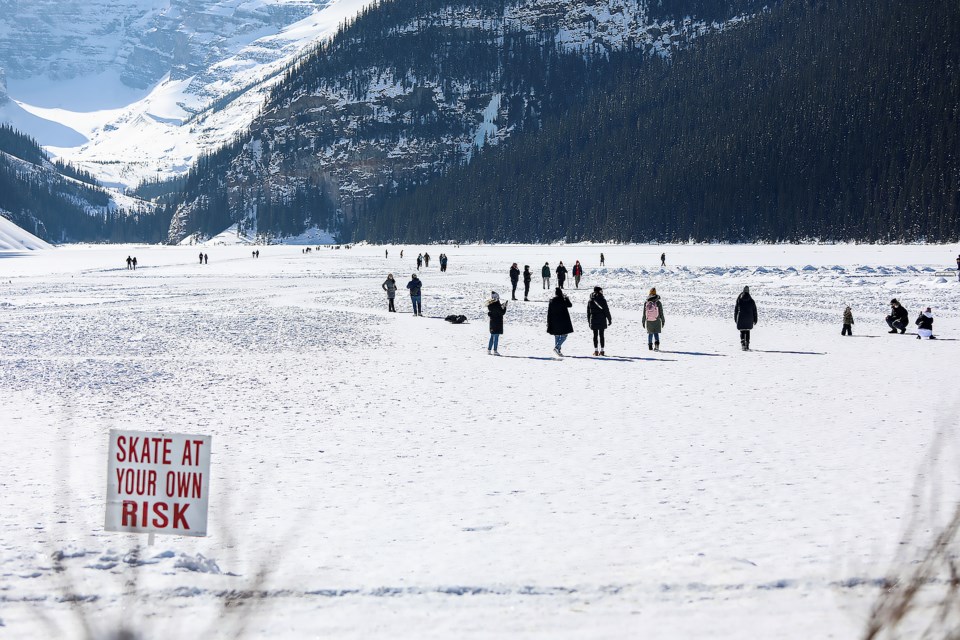BANFF NATIONAL PARK – Careful: you might be treading on thin ice.
Parks Canada visitor safety staff are warning skaters and those planning to recreate on frozen – or seemingly frozen – waterbodies in Banff National Park to be ice-wise ahead of the long weekend.
“It’s really important to check the ice for yourself. It’s something Parks Canada does not monitor. It’s really something people have to determine on their own and evaluate their own risk with that,” said Lisa Paulson, Banff field unit visitor safety specialist.
As bodies of water begin to freeze, people flock to picturesque icy lakes in the mountains, not always aware of the risk that lurks beneath, said Paulson.
“It’s quite alarming when it happens … When the ice fails, it’s actually very quick and you’re suddenly in the water.”
For walking and skating on ice, the Canadian Red Cross indicates ice thickness should be at least 15 centimetres thick.
If skating at a party or playing games like hockey, ice should be at least 20 cm thick.
Ice colour can also be an indicator of thickness, where clear, blue ice may be strongest, white or opaque ice is half as strong and grey is considered unsafe, indicating the presence of water.
While these can be good guidelines to follow, Paulson recommends bringing an ice screw to be sure.
“When I go out, I always bring an ice screw with me,” she said. “I drill the ice and I make sure that it’s 15 cm thick. In my experience in walking around on the ice sometimes, you really don’t know sometimes until you drill it.”
Where one section of ice might be thick enough to skate or walk on, it might not be as safe even a short distance away.
“When we do our thin ice rescue practice, we do find some incredible variability in the ice thickness,” explained Paulson. “So, even though you’ve drilled over one spot, a little way away it can be completely different.
“Certainly, near inlets and outlets, the thickness can vary.”
Other variables include water depth and size of the body of water, currents and moving water, water fluctuation levels and changing air temperature.
“Local conditions and the type of water body will affect the ice strength,” states the Canadian Red Cross’ website.
Nearly every year Parks Canada hears about or responds to someone falling through ice, Paulson said. At certain times of year, during the onset of winter and as temperatures start to warm with the onset of spring, the risk of falling in is greater as ice conditions may be unstable.
Paulson recalls an event Parks Canada responded to a few years ago at Lake Minnewanka.
“A skater fell through the ice and couldn’t get herself out. A bystander tried to rescue her and as they approached, they fell in,” she said.
Fortunately, the bystander was able to get out, but by the time the call came to Parks Canada and the agency responded for a rescue, the woman had been in the water for 30 minutes.
The 1-10-1 rule, coined by Dr. Gordon Geisbreicht – aka Professor Popsicle – is a good guide for understanding the risks of falling into cold water and how long the human body has before it shuts down from hypothermia.
The rule states if you fall into cold water, you have one minute to control breathing, less than 10 minutes for self-rescue, and one hour in the water – at six degrees Celcius – before becoming hypothermic.
“You can imagine how reassuring it’d be to have a life jacket on in that situation,” said Paulson.
“It’s not an unusual thing to see people skating around with a PFD – that would be a good measure just in case.”
Other tools critical in the event of rescue include ice picks and a rope, she added.
In the event you fall through the ice, Paulson said remaining calm, controlling your breath and calling for help nearby is step one.
Next is to reorient your body toward shore and make yourself horizontal by extending your arms and “kicking your legs as hard as you can” to better disperse your weight.
“This also allows you to sort of use the ice picks to pull yourself out toward shore. Then you want to sort of roll over to where the ice is thicker,” said Paulson.
The Local Journalism Initiative is funded by the Government of Canada. The position covers Îyârhe (Stoney) Nakoda First Nation and Kananaskis Country.



